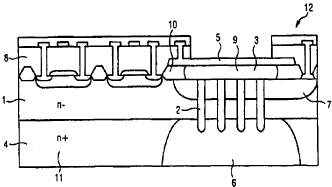Une partie des informations de ce site Web a été fournie par des sources externes. Le gouvernement du Canada n'assume aucune responsabilité concernant la précision, l'actualité ou la fiabilité des informations fournies par les sources externes. Les utilisateurs qui désirent employer cette information devraient consulter directement la source des informations. Le contenu fourni par les sources externes n'est pas assujetti aux exigences sur les langues officielles, la protection des renseignements personnels et l'accessibilité.
L'apparition de différences dans le texte et l'image des Revendications et de l'Abrégé dépend du moment auquel le document est publié. Les textes des Revendications et de l'Abrégé sont affichés :
| (12) Brevet: | (11) CA 2340059 |
|---|---|
| (54) Titre français: | CAPTEUR MICROMECANIQUE ET SON PROCEDE DE PRODUCTION |
| (54) Titre anglais: | MICROMECHANICAL SENSOR AND METHOD FOR PRODUCING SAME |
| Statut: | Réputé périmé |
| (51) Classification internationale des brevets (CIB): |
|
|---|---|
| (72) Inventeurs : |
|
| (73) Titulaires : |
|
| (71) Demandeurs : |
|
| (74) Agent: | FETHERSTONHAUGH & CO. |
| (74) Co-agent: | |
| (45) Délivré: | 2003-12-23 |
| (86) Date de dépôt PCT: | 1999-08-03 |
| (87) Mise à la disponibilité du public: | 2000-02-24 |
| Requête d'examen: | 2001-02-09 |
| Licence disponible: | S.O. |
| (25) Langue des documents déposés: | Anglais |
| Traité de coopération en matière de brevets (PCT): | Oui |
|---|---|
| (86) Numéro de la demande PCT: | PCT/DE1999/002375 |
| (87) Numéro de publication internationale PCT: | WO2000/009440 |
| (85) Entrée nationale: | 2001-02-09 |
| (30) Données de priorité de la demande: | ||||||
|---|---|---|---|---|---|---|
|
L'invention concerne un capteur micromécanique et son procédé deproduction, lequel comprend les étapes suivantes: a) préparationd'une tranche de semi-conducteur (4) dopée; b) application d'unecouche épithaxiale (1) qui est dopée de façon telle qu'à l'interface (11) entre la tranche de semi-conducteur et la couche épitaxiale se présente une discontinuité dans la densité des porteurs de charge; c) éventuellement, création par attaque d'ouvertures deventilation (2) qui traversent la couche épitaxiale et, éventuellement, remplissage des ouvertures de ventilation avec un matériau sacrificiel; d) application d'au moins une couche sacrificielle (9), d'au moins une couche d'espacement (10), d'une membrane (5) et, éventuellement, d'un circuit à semi-conducteur (8), selon une technologie connue en soi, sur la face supérieure de la couche épitaxiale, le circuit à semi-conducteur pouvant être appliquéaprès formation de la membrane ou pendant l'application des couches nécessaires à la formation de la membrane; e) création par attaque d'une ouverture (6) sur la face arrière du capteur, le procédé d'attaque étant choisi de façon telle que le processus d'attaque se produise en direction de la face supérieure et s'arrête à l'interface entre la tranche (4) et la couche épithaxiale (1) parmodification de la concentration des porteurs de charge. L'invention concerne également l'utilisation du capteur micromécanique dans des capteurs de pression ou dans des microphones.
The invention relates to a micromechanical sensor and to a corresponding
production method, comprising the following steps: a) preparing a doped
semiconductor wafer (4); b) applying an epitaxial layer (1) that is doped in
such a way that a jump in the charge carrier density in the interface (11)
between the semiconductor wafer and the epitaxial layer occurs; c) optionally
etching ventilation holes (2) traversing the epitaxial layer and optionally
filling the ventilation holes with a sacrificial material; d) depositing at
least one sacrificial layer (9), at least one spacing layer (10), a membrane
(5) and optionally a semiconductor circuit (8) on the top side of the
epitaxial layer using a technology known per se, wherein the semiconductor
circuit may be applied after the membrane is formed or while depositing the
layers required to form the membrane; e) etching a hole (6) on the back part
of the sensor, wherein the etching method is selected in such a way that
etching advances in the direction of the top side and ceases in the interface
between the wafer (4) and the epitaxial layer (1) by changing charge carrier
concentration. The invention also relates to the utilization of the
micromechanical sensor in pressure sensors or microphones.
Note : Les revendications sont présentées dans la langue officielle dans laquelle elles ont été soumises.
Note : Les descriptions sont présentées dans la langue officielle dans laquelle elles ont été soumises.

Pour une meilleure compréhension de l'état de la demande ou brevet qui figure sur cette page, la rubrique Mise en garde , et les descriptions de Brevet , États administratifs , Taxes périodiques et Historique des paiements devraient être consultées.
| Titre | Date |
|---|---|
| Date de délivrance prévu | 2003-12-23 |
| (86) Date de dépôt PCT | 1999-08-03 |
| (87) Date de publication PCT | 2000-02-24 |
| (85) Entrée nationale | 2001-02-09 |
| Requête d'examen | 2001-02-09 |
| (45) Délivré | 2003-12-23 |
| Réputé périmé | 2005-08-03 |
Il n'y a pas d'historique d'abandonnement
| Type de taxes | Anniversaire | Échéance | Montant payé | Date payée |
|---|---|---|---|---|
| Requête d'examen | 400,00 $ | 2001-02-09 | ||
| Le dépôt d'une demande de brevet | 300,00 $ | 2001-02-09 | ||
| Enregistrement de documents | 100,00 $ | 2001-03-15 | ||
| Taxe de maintien en état - Demande - nouvelle loi | 2 | 2001-08-03 | 100,00 $ | 2001-08-03 |
| Taxe de maintien en état - Demande - nouvelle loi | 3 | 2002-08-05 | 100,00 $ | 2002-07-29 |
| Taxe de maintien en état - Demande - nouvelle loi | 4 | 2003-08-04 | 100,00 $ | 2003-07-22 |
| Taxe finale | 300,00 $ | 2003-10-09 |
Les titulaires actuels et antérieures au dossier sont affichés en ordre alphabétique.
| Titulaires actuels au dossier |
|---|
| INFINEON TECHNOLOGIES AG |
| Titulaires antérieures au dossier |
|---|
| AIGNER, ROBERT |
| BEVER, THOMAS |
| TIMME, HANS-JORG |